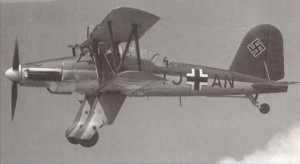 The Fieseler Fi-167 was a two seat single engine biplane designed for use on the Graf Zeppelin aircraft carrier as a torpedo bomber and reconnaissance aircraft.
The Fieseler Fi-167 was a two seat single engine biplane designed for use on the Graf Zeppelin aircraft carrier as a torpedo bomber and reconnaissance aircraft.
It was the winner of a design competition between Fieseler and Arado. Like the famous Storch, the Fi-167 had amazing slow speed capabilities and was able to land almost vertical on a moving aircraft carrier.
Two prototypes were built, and 12 pre-production aircraft. There were very few modifications between the two. The aircraft exceeded all requirements by far, and had excellent handling capabilities and could carry about twice the required weapons payload.
When the construction of Graf Zeppelin was stopped in 1940, the aircraft production was halted, and the 12 aircraft in existence were entering service in Test Group 167 (“Erprobungsgruppe 167″).
After the Stuka took over as the major dive bomber, nine of the Fi-167s were sent to Holland at a naval squadron, until 1943 when they were sold to Romania. The 3 remaining aircraft were used at the German Aircraft Experimantal Institute (Deutsche Vesuchsanstalt fur Luftfahrt”). None exists today.
The specifications:
Length: 11.40 m (37 ft 4 in)
Wingspan: 13.50 m (44 ft 3 in)
Height: 4.80 m (15 ft 9 in)
Powerplant: 1? Daimler-Benz DB 601B
Maximum speed: 325 km/h (176 knots, 202 mph)
Cruise speed: 250 km/h (135 knots, 155 mph)
Range: 1,300 km (703 nmi, 808 mi)
Service ceiling: 8,200 m (26,900 ft)
Guns: 1 7.92 mm MG 17 machine guns, 1 MG-15 machine gun in rear cabin.
Bombs:
1 x 1000 kg (2,200 lb) bomb or
1 x 765 kg (1,685 lb) torpedo or
1 x 500 kg (1,100 lb) bomb plus 4 x 50 kg (110 lb) bombs





 03/06/2011
03/06/2011
Leave a reply